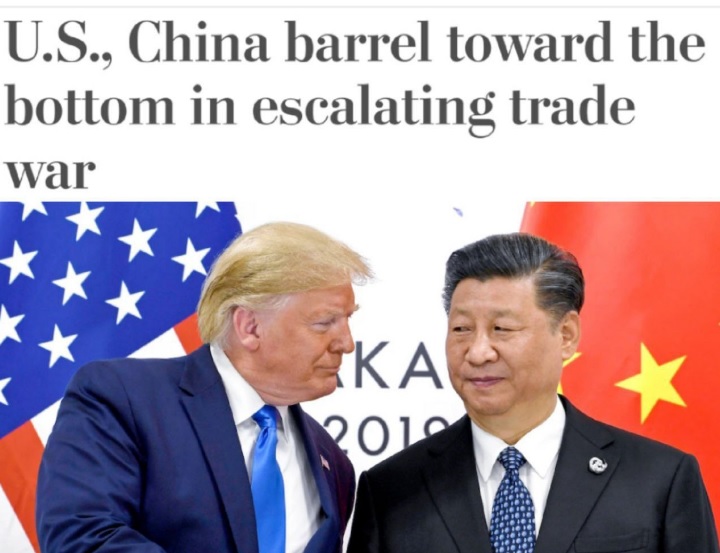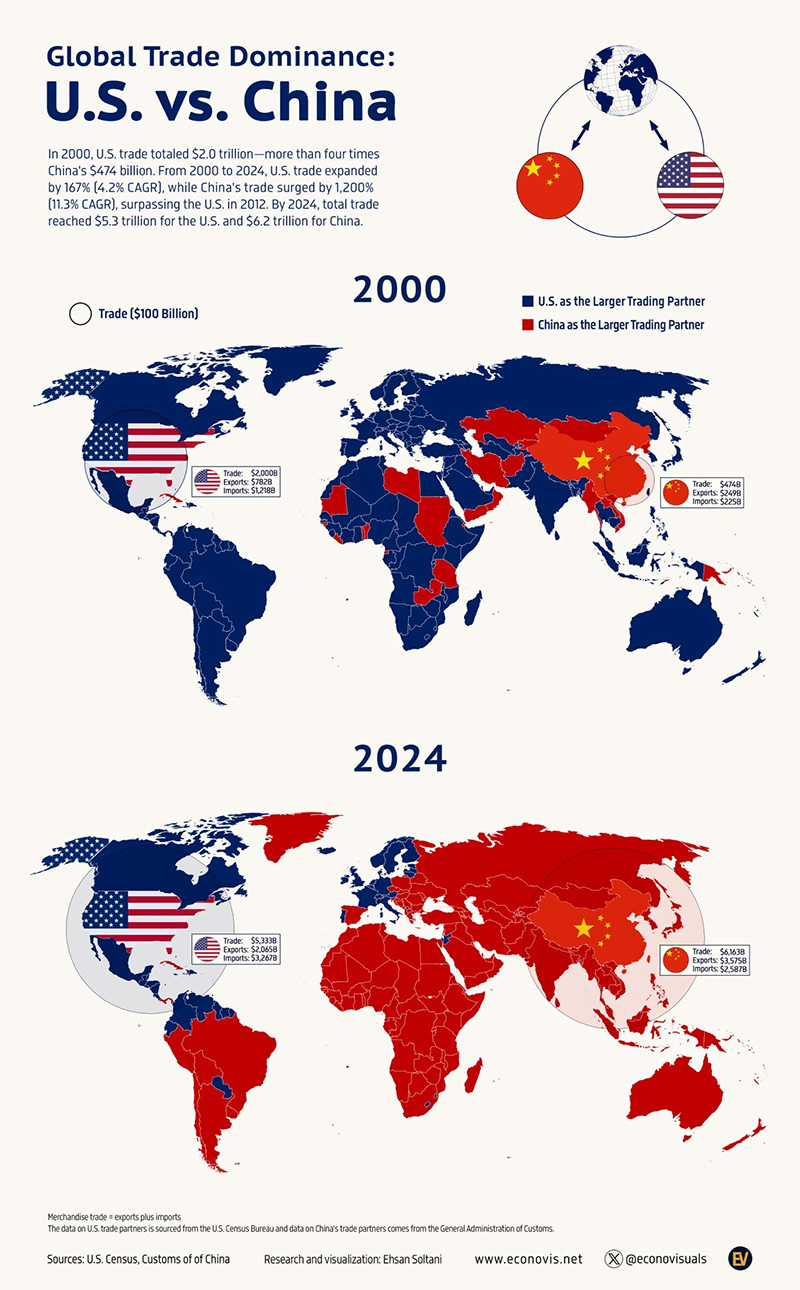
What Trump wants above all is to display dominance and extract submission. A better explanation is that Trump is motivated mainly by a desire to accumulate and exercise power, and tariffs are the best instrument of that power, stresses ‘The Financial Times’.
Trump climbed down from his most extreme reciprocal tariff threats, but we are still left with a 10 per cent minimum levy on almost all US imports, 25 per cent duties on steel, aluminium and cars, and an outlandish 145 per cent tariff on China.
The president’s team is scrambling to rationalise the chaos as a master plan to build a coalition to defeat Chinese mercantilism. But any such plan is doomed to fail. To understand why, we first need to get at what Trump really wants from tariffs. The usual claims — that he wants to crack down on unfair trade practices, eliminate trade deficits, reindustrialise America, confront China — do not hold up. Trump often invokes these goals. But these stated aims often contradict each other, are contradicted by other policies or are obviously unachievable.
A better explanation is that Trump is motivated mainly by a desire to accumulate and exercise power, and tariffs are the best instrument of that power. The purpose of his general trade war is to remove the constraints imposed by the global economic order on the unilateral exercise of US power, and in particular the exercise of power by the president.
Tariffs are the preferred tool for two reasons. First, Trump has believed for decades that the rest of the world will pay any price to gain access to the US market. Second, and perhaps more important, until Congress chooses to stop him, Trump has unlimited personal authority to impose (or withdraw) tariffs on any country, at any time, for any reason.
What Trump wants above all is to display dominance and extract submission. Countries that did not actively resist his tariffs were graciously granted reprieves from the higher rates. The country that dared to defy him was savagely punished.
Most countries now understand that the various economic rationales offered by Trump’s advisers are just window-dressing. So long as Trump is in charge, the US is unreliable and no sane leader will join him in a crusade against China.
Trump had to back off from high tariffs after an adverse market reaction. So Trump has lost his leverage in trade negotiations. He cannot raise tariffs again, because the Treasury market will revolt again.
At first glance China seems worse off now than the US: it has lost access to one of its biggest export markets, and seems diplomatically isolated. But in fact, it is well prepared to fight a war of economic attrition against the US.
China may be losing demand from the US, but this can be replaced by domestic consumer demand, which has been abnormally weak thanks to overly tight monetary policy, and an obsession with pouring state resources into manufacturing. Xi Jinping has reversed course and is now serious about boosting domestic demand.
China can also get along fine without imports from the US. Five years of export controls have helped it get very good at making things without American technology.
Meanwhile the US faces much higher inflation thanks to its tax on Chinese consumer goods. Its reliance on Chinese industrial inputs is three times that of China’s reliance on US components. Higher input prices are already hurting business investment.
If the aim of Trump’s new trade war with China is to get Beijing to bend the knee before US power, the result will only be frustration and disappointment.

The world’s two largest powers are closer to a full economic break than ever, as President Donald Trump and Chinese leader Xi Jinping refuse to back down in a trade war that has become a high-stakes game of chicken — raising the specter of mass economic fallout and heightened risk of conflict between Washington and Beijing, writes ‘The Washington Post’.
A week after Trump’s “Liberation Day” tariffs roiled global markets, his administration has put China in its crosshairs, shifting his global trade war from a crusade against what he called foreign freeloading to a winner-takes-all confrontation with Beijing.
China on Friday countered Washington’s levies by raising tariffs on all U.S. goods to 125 percent, while it dismissed U.S. measures as “economically meaningless” and Xi urged European nations to join Beijing in resisting Trump’s “unilateral bullying.” A day earlier, Trump confirmed he had hiked tariffs on Chinese imports to 145 percent — the fourth such escalation since taking office two months ago. The Trump administration said late Friday that it would exempt many consumer electronics, like the popular iPhone, from tariffs even as it didn’t back down from the broad levies.
But analysts and people close to officials in China’s leadership circles say beneath the growing market panic over the tariffs lies a deeper concern: Trump’s erratic early moves — and the absence of any meaningful back-channel between Washington and Beijing since January — mean there are few tools available to steer the relationship back on course.
“Everyone is so fixated on tariffs, but we are at a level where this is past tariffs; we have backed into decoupling,” said Jude Blanchette, who runs the China Research Center at the Rand Corporation.
“Beijing was tolerant of tariff increases and other increases so long as they thought they had a chance to sit down with Trump and stabilize the relationship. This is so completely off the table now,” he said.
Trump and his appointees are rallying behind the idea that the sudden reversal on implementing most tariffs was a strategic move to outmaneuver Beijing and are now betting that China will back down.
Speaking at an American Bankers Association conference in Washington on Wednesday, Treasury Secretary Scott Bessent said he expects a wave of new deals with U.S. allies and a coordinated approach to confronting China.
But Chinese officials have signaled that Beijing is bracing for a protracted economic battle with the United States — determined not to show weakness at home and still smarting from the belief that it gained little from the intense dealmaking of Trump’s first term.
In Beijing, two people familiar with internal discussions said a core group of senior officials have been tasked with rolling out a set of preplanned measures to match any U.S. economic salvos — including some actions drafted weeks before Trump took office on Jan. 20. They include tariffs on specific U.S. industries and restrictions on U.S. firms.
Lines of communication between the two superpowers came to a screeching halt Monday when Donald Trump posted on Truth Social: “All talks with China concerning their requested meetings with us will be terminated!”
Beijing responded with a sharp warning that it would not bow to “pressure, threats and blackmail.”
“I was really shocked,” said Xin Qiang, deputy director of the Center for American Studies at Fudan University in Shanghai. “I didn’t expect the situation to deteriorate to this extent in just a few days.”
Analysts say the president now faces a ticking clock: managing the escalating standoff with Beijing while scrambling to secure deals with allies hit with tariffs — all in a race to build a united front that could block China from circumventing the hefty trade measures.
“The next 90 days are crucial… If President Trump can ink deals with these 75 countries and get their buy-in to block China’s transshipping efforts, then America has the chance to build a trade coalition that doesn’t include Beijing. It’s an enormous opportunity,” said Michael Sobolik, senior fellow at Hudson Institute.
Transshipping — the practice of rerouting goods through a third country to dodge high tariffs — was a strategy some Chinese companies adopted following the 2018 trade war, using countries like Vietnam as intermediaries.
As the world’s largest exporter, China posted a global trade surplus of around $1 trillion last year and remains heavily reliant on external demand.
Analysts also say the longer the trade war drags on, the more likely it is that retaliation spreads to other areas of rivalry between the two countries.

read more in our Telegram-channel https://t.me/The_International_Affairs

 11:57 15.04.2025 •
11:57 15.04.2025 •






















